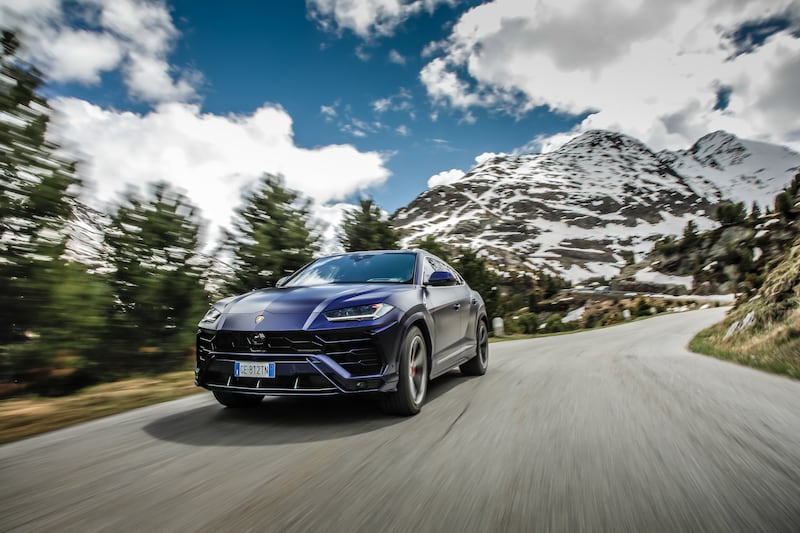On the face of it, this isn’t a fair race. A muscle-bound 650hp Lamborghini Urus against a man with a paraglider propelled solely by thermal air currents. Yet, here we are, assembled in the town of Bormio, nestled in the Italian Alps. Over the next day, we – a handful of journalists – will each be mounted up in a Lamborghini Urus for a race of sorts against paragliding champion Aaron Durogati.
Our convoy will be covering a distance of 161 kilometres along a spectacular route that will take us from Bormio to Pinzolo. Along the way, we’ll have our “race” with Duragoti, who will take off from the lofty heights of Passo Gavia, 2,652 metres above sea level. He’ll take the airborne route to the valley below, while we will have to negotiate a narrow, winding road – strewn with tight hairpin bends.
Durogati grew up in the nearby town of Merano and was introduced to paragliding by his father at the age of 6. The adventure-seeking youngster had to wait another nine years before his father permitted him to make his first solo flight.
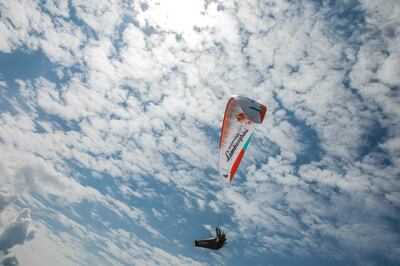
A man with a deep love for the mountains – a sentiment that remains undiminished to this day – Durogati, who is now 35, excelled at Alpine sports. He started skiing when he was a toddler and was racing by the time he was 10. Although his competitive instincts are now focused on paragliding, the soft-spoken Italian still enjoys mountaineering and free-riding – skiing along ungroomed terrain, with no set course or rules. His love for paragliding and skiing also comes together via “speed-riding”, a sport that combines both disciplines.
Durogati’s sporting CV is lengthy, with highlights that include a Paragliding World Cup title in 2012, which he describes as “the most emotional moment of my life until then”. His focus then shifted to the Red Bull X-Alps, which combines elements of hiking and flying as part of a gruelling race.
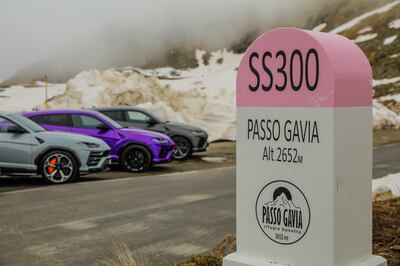
When conditions are good during the Red Bull X-Alps, athletes use their paragliders to fly, and when they are not, they must run or hike, carrying their paraglider and other equipment. The use of tunnels and all other forms of transport are not permitted. The first Red Bull X-Alps, in 2003, stretched from Austria's Dachstein Glacier to Monaco via Germany's highest mountain, the Zugspitze, as well as Mont Blanc and Mont Gros in France. Seventeen athletes and their support teams covered a distance of 800 kilometres as the crow flies.
Although being suspended thousands of feet in the air by a fabric chute and cables might seem a hair-raising prospect, Duragoti says paragliding is not an “extreme sport”. That said, it’s not without risk, and competitors in the Red Bull X-Alps need to be in peak physical condition.
Speaking of which, the Lamborghini Urus is as rapid and dynamic as an SUV gets. The sharp-edged all-terrainer took the Raging Bull marque well away from its supercar roots when it launched in 2018, opening up the brand to a whole new set of buyers.
The company’s balance sheet shows it was a well-considered move, as Lamborghini’s annual sales figures have more than doubled since the introduction of the Urus. The marque’s previous best annual sales tally was 3,815 units (in 2017), whereas in 2019, total sales had multiplied to 8,205 units. Last year would have been even better, had the onset of Covid-19 not halted production at Lamborghini’s Sant’Agata Bolognese factory for seven weeks.
Order a new Urus today and you could be waiting anywhere between six and nine months for your vehicle, illustrating how high demand is for the SUV. It’s not hard to see why. “It’s the only vehicle that enables you to conquer dunes, yet still be able to hit 305kph on the tarmac,” says Emanuele Camerini, a spokesman for Lamborghini. This also explains why Urus owners cover more than double the number of kilometres each year, compared to the Huracan and Aventador.
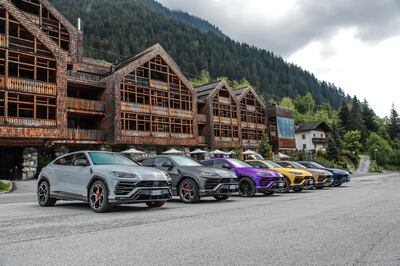
The Urus is backed by a formidable set of credentials. At its heart lies a 4.0-litre twin-turbo V8 engine that thumps out 650hp and 850Nm, which spears it from zero tp 100 kilometres an hour in 3.6 seconds, and on to 200kph in only 12.8 seconds. These are stats that wouldn’t look out of place on a supercar.
The Urus isn’t merely a straight-line bully, though, as it comes armed with a state-of-the-art four-wheel-drive system with active torque-vectoring and four-wheel-steering. It also has huge carbon-ceramic brakes, adaptive air suspension and active roll stabilisation, which combine to deliver all-road pace and potency that are almost unthinkable for a 2.2-tonne SUV that stands at more than 1.6 metres tall.
As we charge across our mountainous route, the Urus feels much more compact than it is. The roads we’re traversing are extremely narrow, with a mountain face on one side and a sheer drop on the other. Yet, the big Lambo makes easy work of it, with the four-wheel-steer playing its part in boosting agility – something that’s especially noticeable on the tight hairpins.
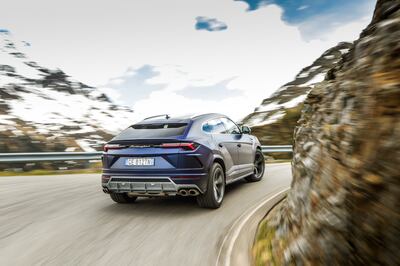
Meanwhile, Durogati, who had just leapt off the edge of the cliff at Passo Gavia, is doing his best to make a beeline for the designated landing spot in the valley below. The paragliding ace says the key to being successful in his sport is to be able to read the thermal drafts and best exploit them to travel as quickly and efficiently in a chosen direction. One insightful clue: “The air above brown fields is warmer than air over green fields. The idea is to stay in that tube of warm air.”
Back on terra firma, our thundering Urus fleet is making brisk progress across the sinuous mountain road. Some light rain has begun to fall, but this has no effect on our pace, as the combination of all-wheel-drive traction and the massive footprint provided by the Pirelli rubber ensures the Lambo remains glued to the tarmac.
The Urus has no less than six drive modes – Strada (Highway), Sport, Corsa (Track), Neve (Snow), Sabbia (Sand) and Terra (gravel and rock) – enabling the chassis and drivetrain to be optimised for any surface. We remain predominantly in Sport mode, which sharpens performance and makes the twin-turbo V8 more vocal. An off-road stint later in the day enables us to use Terra as well.
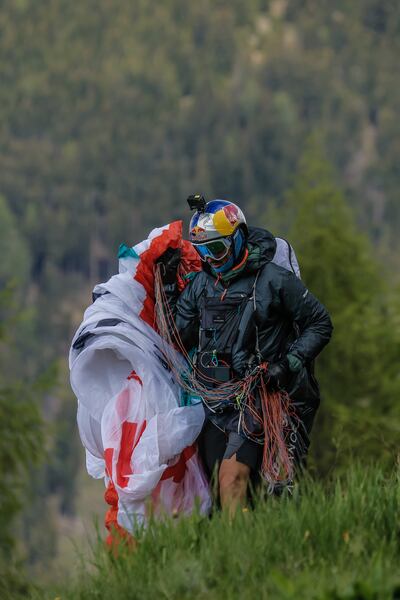
As the landing spot looms up ahead, we see that Durogati has already arrived, and is gathering up his billowing chute and the myriad lines that connect his harness to it. It’s proof that the aerial route is almost invariably the quickest way to get from Point A to B.
Apart from being an exhilarating experience, our road-versus-air race serves to highlight the Urus’s breadth of capability and sheer pace across all surfaces. There’s a strong synergy with the “conquer all terrain and elements” philosophy of competitive paragliding, which explains why Durogati is a Lamborghini brand ambassador. The Italian flyer is peerless in the air, while the Urus has few equals on the ground.
